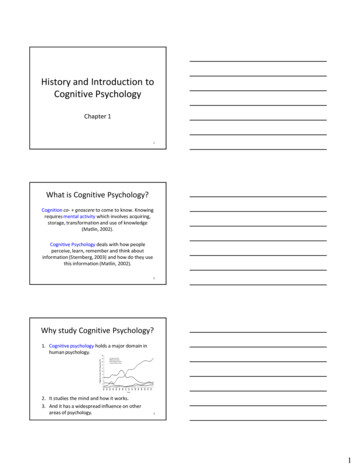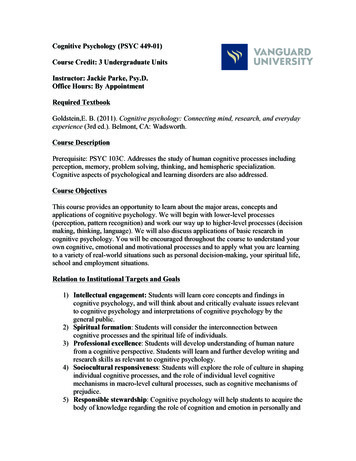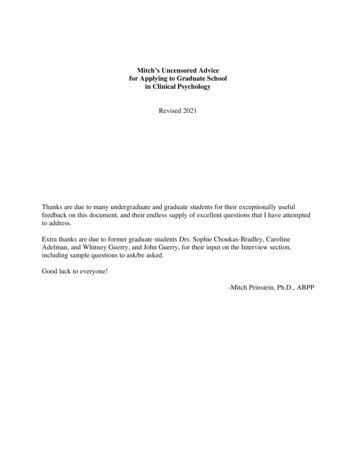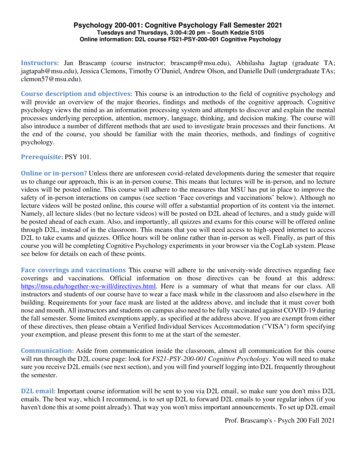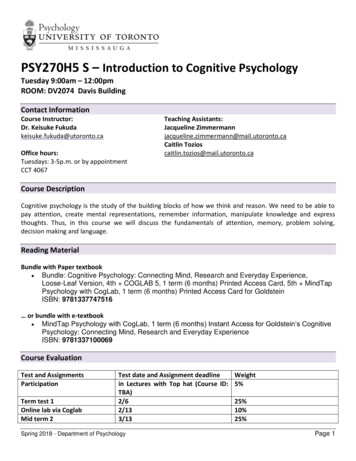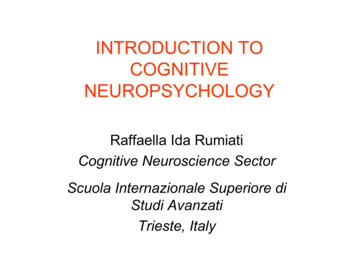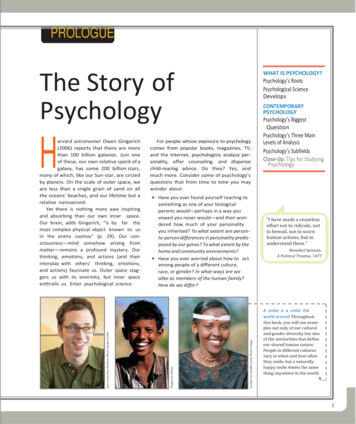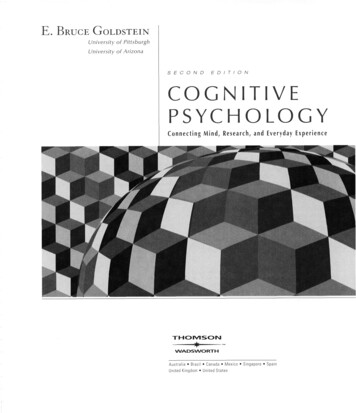
Transcription
E . BRUCE G O L D S T E I NUniversityofPittsburghUniversityofArizonaSECONDE D I T I O NCOGNITIVEPSYCHOLOGYConnecting M i n d , Research, and Everyday ExperienceT H O M S O N-ФWADSWORTHAustralia Brazil Canada Mexico Singapore SpainUnited Kingdom United States
ContentsChapter 1Introduction to Cognitive Psychology 1The Challenge of Cognitive Psychology3The Complexity of Cognition3The First Cognitive Psychologistsы Method: Reaction Time 6The Decline and Rebirth of Cognitive Psychology510The Rise of Behaviorism11The Decline of Behaviorism12The Cognitive Revolution13How Do Cognitive Psychologists Study the Mind?16Behavioral and Physiological Approaches to Cognition16The Behavioral Approach: Measuring Mental Rotation17 Demonstration: Comparing Objects 17The Physiological Approach: The Relationship Between Brain Activity and MemoryModels i n Cognitive Psychology19Something to Consider: Studying Cognition Across Many DisciplinesTest Yourself 1.122Chapter Summary23Think About It 24If You Want to Know More 24Key Terms 25CogLab: Mental Rotation 25Chapter 21921Cognition and the Brain: Basic Principles 27Neurons: The Building Blocks of the Nervous System 30Neurons Transform Environmental Energy Into Electrical Energyи Method: Recording From Single Neurons 32How Neurons Communicate34Communication Between Neurons Occurs at the Synapse34Excitation and Inhibition Interact at the Synapse35How Neurons Process Information3036Neurons Process Information by Interacting With Each Other36Neural Processing Creates Neurons That Respond to Specific Types of Stimuli38H
Test Yourself 2.140How Stimuli Are Represented by the Firing of Neurons40The Neural Code for Perceiving Faces41The Neural Code for Other Cognitive CapacitiesCognitive Processes and the Brain4242Layout of the Brain43Different Areas of the Brain Serve Specific FunctionsпMethod: Neuropsychology4343Cognitive Processes Are Signaled by Activity in Many Areas of the BrainпMethod: Brain ImagingInteracting With the Environment Affects Operation of the Nervous SystemSomething to Consider: Are There Grandmother Cells After All?Test Yourself 2.25252If You Want to Know MoreKey Terms5353CogLab: Receptive Fields; Brain AsymmetryChapter 354Perception 55Bottom-Up and Тор-Down Processing in PerceptionH57Demonstration: Perceiving a PictureRecognizing Letters and Objects5961Template Matching61Interactive Activation Modelи485051Chapter SummaryThink About It454562Method: Word Superiority Effect64Feature Integration Theory (FIT)66Recognition-by-Components T h e o r yTest Yourself 3.16972Perceptual Organization: Putting Together an Organized World72The Gestalt Laws of Perceptual OrganizationШ Demonstration: Finding Faces in a Landscape7478The Gestalt Laws Provide "Best Guess" Predictions About What Is Out ThereWhy Computers Have Trouble Perceiving Objects7880The Stimulus on the Receptors Is Ambiguous81Objects Need to Be Distinguished From Their Surroundings and From Each OtherObjects Can Be Hidden or Blurred82The Reasons for Changes of Lightness and Darkness Can Be Unclear83How Experience and Knowledge Create "Perceptual Intelligence"Heuristics for Perceiving8484Ш Demonstration: Shape From Shading86Knowledge Helps Us Perceive Words in Conversational SpeechШ Demonstration: Organizing Strings of Sounds87Neurons Contain Information About the EnvironmentSomething to Consider: Perception Depends on AttentionContents91908781
fr Demonstration: Change DetectionTest Yourself 3.2Chapter SummaryThink About It9495If You Want to Know MoreKey Terms92949697CogLab: Change Detection; Apparent Motion; Blind Spot; Metacontrast Masking; Muller-Lyer Illusion; Signal Detection;Visual Search; Garner InterferenceChapter 497Attention 99Selective Attention: When Does Selection Occur?101fr* Demonstration: Hearing Two Messages at OncenMethod: Dichotic Listening102102Early Selection: Broadbent's Filter Model103Intermediate Selection: Treisman's Attenuation TheoryLate-Selection M o d e l sHow Does Task Load Affect Selective Attention? 110Method: Flanker-Compatibility TaskTest Yourself 4.1106109111113Divided Attention: Paying Attention to More Than One ThingPractice Can Lead to Automatic Processing** Demonstration: Stroop Effect114114117Automatic Processing Is Not Possible for Difficult Tasks117Divided Attention in the Real World: Inattention and DrivingAttention and Visual Processing120Directing Visual Attention With the EyesC3 Method: Measuring Eye Movements120120Directing Visual Attention Without Eye MovementsnMethod: Precueing125Something to Consider: Attention in Social Situations-The Case of Autism130131If You Want to Know MoreKey Terms127130Chapter SummaryThink About It122123Object-Based Visual AttentionTest Yourself 4.2118132133CogLab: Stroop Effect; Spatial Cueing; Attentional Blink; Change Detection; Simon Effect; Von Restorff EffectChapter 5134Short-Term and Working Memory 135What Is Memory?136The Purposes of Memory136The Modal Model of Memory13 8Sensory Memory141The Sparkler's Trail and the Projector's Shutter141Contentsm
Sperling's Experiment: Measuring the Visual IconShort-Term Memory145What Is the Duration of Short-Term Memory?142146*" Demonstration: Remembering Three Letters146What Is the Capacity of Short-Term Memory?148& Demonstration: Digit Span148H o w Is Information Coded i n Short-Term Memory?Test Yourself 5.1150153Working Memory: The Modern Approach to Short-Term Memory154 Demonstration: Reading Text and Remembering NumbersT h e Phonological Loop156H Demonstration: Phonological Similarity Effect Demonstration: Word-Length Effect154157157 Demonstration: Articulatory Suppression 158The Visuospatial Sketch Pad159f- Demonstration: Holding a Verbal Stimulus in the Mind * Demonstration: Holding a Spatial Stimulus in the MindT h e Central Executive162160160Update on the Working Memory Model: Addition of the Episodic Buffer163Working Memory and the Brain 164The Delayed-Response Task in MonkeysNeurons That Hold Information166Brain Imaging in Humans167165Something to Consider: Working Memory in American Sign LanguageTest Yourself 5.2Chapter SummaryThink About It171172If You Want to Know MoreKey Terms168170173174CogLab: Partial Report; Brown-Peterson; Memory Span; Phonological Similarity Effect;Apparent Movement; Irrelevant Speech Effect; Modality Effect; Operation Span; Position Error;Sternberg SearchChapter 6174Long-Term Memory: Basic Principles 176Introduction to Long-Term Memory179Distinctions Between LTM and STM*Demonstration: Serial Position " Demonstration: Reading a PassageTypes of Long-Term Memory181182186186Declarative Memory 187Episodic and Semantic Memory187The Separation of Episodic and Semantic MemoriesConnections Between Episodic and Semantic MemoriesImplicit Memory191Repetition PrimingContents192188189
nMethod: Repetition Priming Method: Recognition and Recall192193Procedural Memory195An Example of Implicit Memory in Everyday ExperienceHow Does Information Become Stored in Long-Term Memory?Maintenance Rehearsal and Elaborative RehearsalLevels-of-Processing Theory197 Demonstration: Remembering ListsиMethod: Varying Depth of Processing196196197198199Transfer-Appropriate Processing200Additional Factors That Aid Encoding202вDemonstration: Reading a ListTest Yourself 6.1204207How Are Memories Stored in the Brain?207Information Storage at the Synapse208Forming Memories in the Brain: The Fragility of New Memories208Forming Memories in the Brain: The Process of Consolidation210Memory for Emotional Stimuli213How Do We Retrieve Information From Long-Term Memory?Retrieval CuesE3 Method: Cued Recall216Encoding Specificity218State-Dependent Learning220What Memory Research Tells Us About StudyingElaborate and GenerateOrganize222Associate223Take Breaks223221221M a t c h L e a r n i n g and T e s t i n g C o n d i t i o n sSomething to Consider: Are Memories Ever "Permanent"?г з Method: Fear ConditioningTest Yourself 6.2225225229231If You Want to Know MoreKey Terms224228Chapter SummaryThink About It215215231233CogLab: Serial Position; Implicit Learning; Levels of Processing; Encoding Specificity; Suffix Effect;Von Restorff EffectChapter 7233Everyday Memory and Memory Errors 235Prospective Memory: What I'm Going to Do Later237Autobiographical Memory: What Has Happened in My Life238The Multidimensional Nature of Autobiographical MemoryMemory Over the Life Span240Flashbulb Memories242n Method: Repeated Recall244239
The Constructive Nature of Memory249Bartlett's "War of the Ghosts" Experiment250Educated Guesses About High School Grades251Source Monitoring and Source Monitoring Errors252Test Yourself 7.1253Making Inferences254 Demonstration: Reading Sentences 254Schemas and Scripts256Remembering a List of Words258Ш Demonstration: Memory for a List 258The Advantages and Disadvantages of ConstructionMemory Can Be Modified or Created by SuggestionT h e Misinformation Effect261259260E3 Method: Presenting Misleading Postevent Information261Creating False Memories for Early Events i n People's Lives264Why Do People Make Errors in Eyewitness Testimony?266Errors of Eyewitness Identification267The Crime Scene and Afterward268W h a t Is Being Done?272Something to Consider: Memories of Childhood AbuseTest Yourself 7.2Chapter SummaryThink About It276279If You Want to Know MoreKey Terms275276279281CogLab: Remember/Know; False Memory; Forgot It All Along EffectChapter 8281Knowledge 283Categories Are Essential, but Definitions Don't Work284W h y Categories Are Useful284W h y Definitions Don't W o r k for Categories286Determining Categories by Similarity: Using Prototypes or Exemplars288T h e P r o t o t y p e A p p r o a c h : F i n d i n g the Average Case 288 Demonstration: Family Resemblance 290и Method: Sentence Verification Technique 291T h e Exemplar Approach: T h i n k i n g About Examples293W h i c h Approach Works Best: Prototypes or Exemplars?294Is There a Psychologically "Privileged" Level of Categories?295Rosch's Approach: What's Special About Basic-Level Categories?NDemonstration: Listing Common Features* " Demonstration: Naming Things296297How Knowledge Can Affect CategorizationTest Yourself 8.1297298Representing Relationships Between Categories: Semantic Networks299
Introduction to Semantic Networks: Collins and Quillian's Model299п Method: Lexical Decision Task 303Criticism of the Collins and Quillian Model304Collins and Loftus Answer the Critics305Assessment of Semantic Network Theories306Representing Concepts in Networks: The Connectionist Approach 307Categories in the Brain 314Something to Consider: The Effect of Culture on "Basic" Levels for Categorization and for InferenceTest Yourself 8.2 318Chapter Summary 318Think About It 320If You Want to Know More 320Key Terms 320CogLab: Prototypes; Lexical Decision; Absolute Identification 321Chapter 9Visual Imagery 322What Is Imagery, and What Is It For? 323The Uses of Visual Imagery323The Plan of This Chapter324Imagery in the History of Psychology 325Early Ideas About Imagery325Imagery and the Cognitive Revolution325a Method: Paired-Associate Learning 326Imagery and Perception: Do They Share the Same Mechanisms? 327Kosslyn's Mental-Scanning Experiments327a Method/Demonstration: Mental Scanning 328The Imagery Debate: Is Imagery Spatial or Propositional?Comparing Imagery and Perception332Is There a Way to Resolve the Imagery Debate?336Test Yourself 9.1 336Imagery and the Brain 337Imagery Neurons in the Brain337Brain Imaging338Transcranial Magnetic Stimulation340u Method: Transcranial Magnetic Stimulation (TMS)Neuropsychological Case Studies341Conclusions From the Imagery Debate346Using Imagery to Improve Memory340347Visualizing Interacting Images347Placing Images at Locations348 * Demonstration: Method of Loci348Associating Images With Words349Something to Consider: Mental Representation of Mechanical Systems Demonstration: Mechanical Problems 350350328
Test Yourself 9.2 352Chapter Summary 352Think About It 353If You Want to Know More 354Key Terms 355CogLab: Mental Rotation; Link WordChapter 10355Language 356What Is Language? 357The Creativity of Human Language357The Universality of Language358Studying Language in Cognitive PsychologyPerceiving and Understanding Words 360Components of Words361Perceiving Words361Understanding Words363ft Demonstration: Lexical Decision Taskn Method: Lexical Priming 365364Summary: Words Alone and in SentencesUnderstanding Sentences358367368Semantics and Syntax368a Method: Event-Related Potential 368Parsing a Sentence370Test Yourself 10.1 376Understanding Text and Stories 377How Inference Creates Coherence377Situation Models379Producing Language: Speech Errors 381n Method: Identifying Speech Errors382Speech Errors and Language Mechanisms382Producing Language: Conversations 383Semantic Coordination383Syntactic Coordination384ы Method: Syntactic Priming 385Something to Consider: Culture, Language, and Cognition 387C J Method: Categorical Perception 387Test Yourself 10.2 388Chapter Summary 389Think About It 390If You Want to Know More 391Key Terms 393CogLab: Word Superiority; Lexical Decision; Categorical Perception-Identification;Categorical Perception-Discrimination 394
Chapter 11Problem Solving 395What Is a Problem?396The Gestalt Approach: Problem Solving as Representation and RestructuringRepresenting a Problem in the Mind398Insight in Problem Solving398И Demonstration: Two Insight ProblemsObstacles to Problem Solving401Ш Demonstration: The Candle Problem399401Modern Research on Problem Solving: The Information-Processing ApproachNewell and Simon's Approach405 Demonstration: Tower of Hanoi Problem 405T h e Importance of How a Problem Is StatedMethod: Think-Aloud ProtocolTest Yourself 11.1404408** Demonstration: The Mutilated-Checkerboard Problemn397409412413Using Analogies to Solve Problems413c a Method: Analogical Transfer 414Analogical Problem Solving and the Duncker Radiation ProblemШ Demonstration: Duncker's Radiation ProblemAnalogical Encoding419Analogy in the Real World 414420Method: ln-vivo Problem-Solving ResearchHow Experts Solve Problems414420421Some Differences Between How Experts and Novices Solve Problems421Creative Problem Solving 423Ш Demonstration: Creating an ObjectSomething to Consider: Sleep Inspires InsightTest Yourself 11.2429Chapter SummaryThink About It430431If You Want to Know MoreKey Terms426428432432Chapter 12Reasoning and Decision Making 434Deductive Reasoning: Thinking Categorically437Validity and Truth in Syllogisms437How Well Can People Judge Validity?Mental Models of Deductive Reasoning438440Deductive Reasoning: Thinking Conditionally 443Forms of Conditional Syllogisms443W h y People Make Errors in Conditional Reasoning: The Wason Four-Card ProblemШ Demonstration: Wason Four-Card ProblemTest Yourself 12.1445452Contents445
Inductive Reasoning: Reaching Conclusions From EvidenceT h e Nature of Inductive Reasoning452The Availability Heuristic456452Ш" Demonstration: Which Is More Prevalent? 456The Representativeness Heuristic459 Demonstration: Judging Occupations459Ш Demonstration: Description of a Person460Ш Demonstration: Male and Female Births461T h e Confirmation Bias462Culture, Cognition, and Inductive Reasoning 463Demonstration: Questions About Animals463Decision Making: Choosing Among Alternatives466The Utility Approach to Decisions466Decisions Can Depend on How Choices Are Presented469 Demonstration: What Would You Do?469Justification in Decision Making471The Physiology of Thinking472The Prefrontal Cortex473Neuroeconomics: The Neural Basis of Decision Making475Something to Consider: Is What Is Good for You Also Good for Me? 476i f Demonstration: A Personal Health DecisionTest Yourself 12.2478Chapter Summary479Think About It481If You Want to Know MoreKey Terms477481483CogLab: Wason Selection Task; Typical Reasoning; Risky Decisions; Decision Making; Monty HallGlossary485References507Name Index539Subject Index544
COGNITIVE PSYCHOLOGY Connecting Mind, Research, and Everyday Experience THOMSON -Ф WADSWORTH Australia Brazil Canada Mexico Singapore Spain United Kingdom United States . Contents Chapter 1 Introduction to Cognitive Psychology 1
